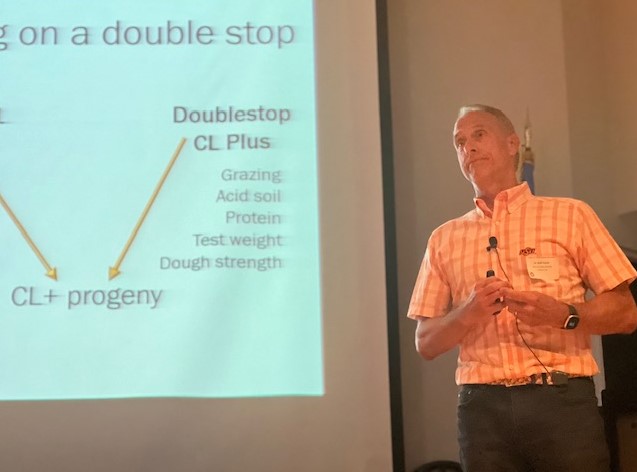
At the 2022 Oklahoma Wheat Growers Association annual meeting in Stillwater, Okla., Farm Director, KC Sheperd, had the chance to visit with Oklahoma State University Wheat Genetics Chair, Brett Carver, talking about the OSU wheat breeding program.
“As far as what really stands out and might be what I see on the horizon first is probably going to be an experimental line that we call 18510 right now,” Carver said. “It is just a Ruby Lee Pioneer derivative that I think has a lot of potential for a lot of places in Oklahoma and that is what we like to see- something that can go far and wide in Oklahoma.”
Carver also talked about the Doublestop Legacy launch where they will be combining a few varieties to yield some amazing results.
“We are just getting more out of Doublestop genetics,” Carver said. “It is really our best yield, protein, quality, and all those stress tolerances that we talked about all wrapped into one genetics, but we have only been able to capitalize on that in our Clearfield line, so if it is not a herbicide-tolerant clear field, then you don’t really get the benefit from Doublestop. That is changing- that is what is happening here.”
Carver went on to talk about the herbicide-tolerant trait present in CoAxium.
“This is new game for us,” Carver said. “We wanted to make sure to start out on the right genetic foot in this case, and I think we did that. I think we have something that is really adapted well to Oklahoma. What we don’t know yet and hope to find out next crop year is how much tolerance we have to the herbicide because if the wheat plant can’t survive the herbicide treatment, then we don’t have any good there.”
Carver said there might be a wheat variety release in 2023 if everything goes as planned
“I think if everything goes right and we get the seed production we should be getting this coming crop year, we can announce something by this time next year,” Carver said. “I would like to announce something in February, actually, but we won’t know as far as the seed production until June.”
Carver said they won’t have a CoAxium variety out at the same time because that will take two to three years and statewide testing to achieve.
“On other, non-CoAxium material we have- the Doublestop Legacy and the 18510, even a scab-resistant line- I think those are genetics we can talk about and possibly talk in terms of release,” Carver said.
For 2023, Carver said they are hoping for good weather to get a crop in the ground.
“We didn’t have a very good start last year, so if we can get the places we want to test and we can get that wheat germplasm out there I will be happy,” Carver said. “But from there, we have a lot of options to pursue in terms of commercial genetics.”
When talking about hard red winter wheat, Carver said it does a lot of things, but there is nothing special about something that does everything.
“The thing with hard red winter wheat that you have to compensate for is, it doesn’t do excellent,” Carver said. “It doesn’t do excellence in a lot of places, so we make up for that by adding vital wheat gluten, or just gluten. You see that on the labels- gluten. And that is on there because hard red winter wheat is insufficient in meeting certain needs.”
For example, Carver said, a hamburger bun will need a tough piece of dough which is accomplished with gluten. When you add the gluten, Carver said, you also must add other additives or conditioners that make up for some of the deficiencies that you get by adding gluten.
“So, what we would like to do is rely a little bit less on adding gluten,” Carver said. “Let’s make sure that what we have in the native state is sufficient to make those buns, to make that sandwich bread, to make that whole wheat bread- it has to go through a lot of stress to make.”
In a new line of genetics called BX7, Carver said they have managed to combine the protein that is already present in wheat with other genetics to achieve a variety that requires less gluten added.
The ultimate goal, Carver said is already having the strength present in these varieties so that additional wheat gluten does not need to be added in to get more strength.
“In the long run, what that does is, it makes that label look a lot cleaner because we are not adding gluten and we are not adding the things we had to correct for with the gluten being added,” Carver said.
Click the LISTEN BAR below to hear more from KC Sheperd and Brett Carver talking about OSU wheat research and varieties.

















